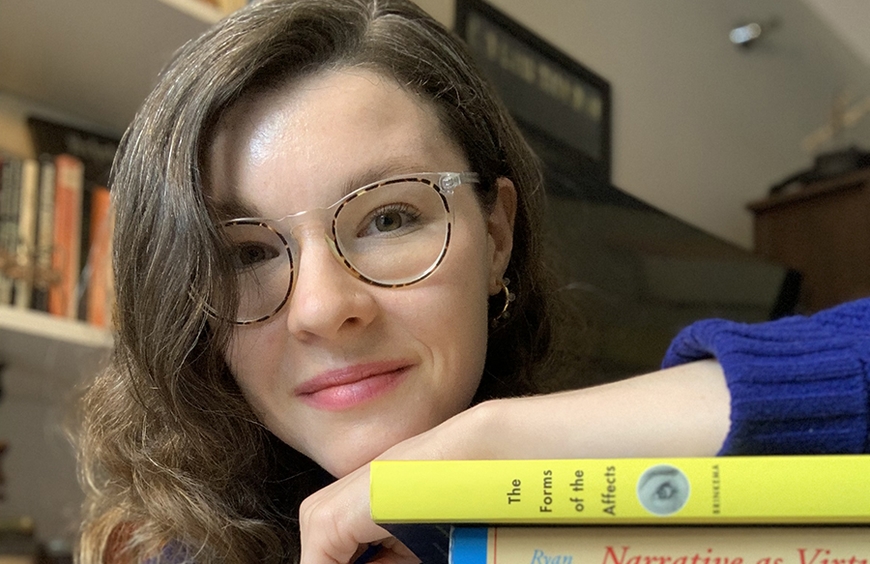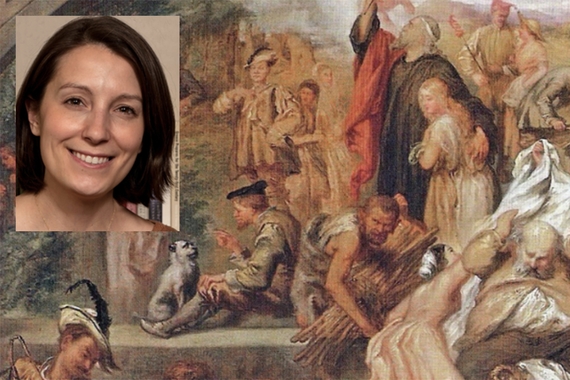Grad Studies: Digital Age Narratives
Jacqueline Patz DiPiero is a doctoral candidate in English literature who received the Graduate School's Doctoral Dissertation Fellowship for 2021-2022 and department Graduate Research Partnership Program support in 2020 to continue working on the dissertation "In the Air: Atmospheric Totality and the Death of Plot."
When I first entered the PhD program, I never could have imagined just how much my dissertation would change and grow over the years. I always have been interested in the relationship between a text’s formal composition and the consumption experience it offers, particularly within today’s digital entertainment mediascape. Consuming a text now can mean spending hours, days, or weeks bingeing a multi-season television series, a suite of superhero films, or a story-driven video game, leading me to ask: how have these new avenues of consumption altered the form and function of digital age narrative?
"This prioritization of atmosphere
has led to the emergence of four
main qualities I argue characterize
digital age narrative: recyclability,
bingeability, interactivity, and
immersivity."
- Jacqueline Patz DiPiero
Supported by my 2020 GRPP funding, I continued working to answer this question in my dissertation, which focuses on atmosphere within contemporary narrative. Years ago, I began analyzing the form of a variety of texts, as well as generic trends and resonances across the production and marketing of digital media, and gradually I felt my attention drawn to the way in which various textual components frequently are deployed in service of creating an overarching atmospheric experience for consumers. Contemporary narratives, I argue, emphasize atmosphere above all else; a text’s feeling matters more than plot or characters now that we create and select stories not simply by genre, but by the mood that they evoke. My dissertation reveals how this prioritization of atmosphere has led to the emergence of the four main qualities I argue characterize digital age narrative: recyclability, bingeability, interactivity, and immersivity.
Last year I also completed an analysis of the use of first-person voice to create textual atmosphere. This project initially was envisioned as a component of my dissertation. Now it is the foundation of an article I am preparing for submission to a journal; I intend for the article, “Speaking ‘I’ Across Medium: First-Person Reliability and Intergeneric Form,” to comprise the backbone of a second book project on living history, true crime, and creative nonfiction.
My research funding also supported my academic work beyond the dissertation. Lately, I have been thinking a good deal about our relationship with media during the coronavirus pandemic’s quarantine period. Last June I published a reflection on the early stages of the pandemic in SCMS+, an online experimental initiative of the Society for Cinema and Media Studies (SCMS). Part of the “Short Attention Span Criticism” issue, the essay, “Nowhere Else to Be: Time, Space, and the Fiction of Synchronicity,” is a reconceptualization of the relationship between physical space and the temporal notion of synchronicity. In addition, I submitted a proposal for a paper entitled “Consuming the Pandemic: Rehearsing the End Through Representational Narrative,” which I presented virtually at the SCMS national conference in March 2021. A study of the act of consuming pandemic-focused narratives during a pandemic, my paper grapples with the relationship between narrativity, affective consumption, and determinism.



